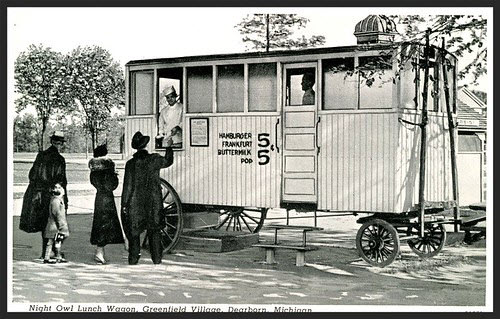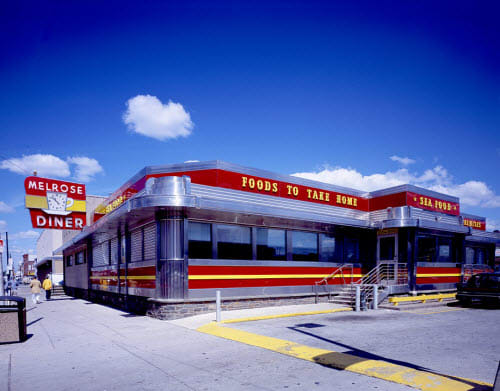Novel, charming and quintessentially American, there is nothing like a classic diner. A combination of a shiny interior, theatrical décor, laminated restaurant tables, cramped diner booths, nostalgic wall art, with low priced comfort food is an American staple. Whether you are on a road trip looking for somewhere to stop into eat or looking to grab a quick bite, you can count on an iconic diner to get it right. However, you may notice that most of these diners bear a striking resemblance to train cars picked off the rails and placed in a city street because that is how they essentially once were.
The History of Classic Diners: From Dining Cars to Fast Service Restaurants

How It Began

All diners are built from the same blueprint the same type of booth seating arrangements, neon signage and an esque format of a train carriage. But each diner has its own distinct character and soul. Diners look like rail carriages because they once were for the most part – they were converted into mobile eateries and built to replicate them. Learning how the trend started requires a time travel back in time to the 19th century and then forward to New Jersey which remains America’s undisputed diner capital to this very day.
Nowadays, there is a broad spectrum of eateries that claim as diners. There are national chains and there are independent establishments staffed by proprietors. There are even some trendy and hipster diners with more expensive menu items. But “mobile” is a word most people don’t associate with diners. But that is how they started off. In 1872, Walter Scott, a printer by trade, created the concept by inventing the night lunch wagon. He would there serve hot yet inexpensive meals to hungry travelers out of a horse drawn wagon that he had converted into a car – similar to what we currently recognize as a modern day food truck! Customers, especially those on the go, would be served their meals out of the wagon’s window. Gain popularity hereon out, the night lunch wagon sparked the creation of rolling restaurant - a couple of seats in a car allowing you to eat while traveling to your destination. Shortly after, these type of restaurants evolved into dining cars; restaurants built from train cars. They featured rows of boldly colored diner booths lined up against the windows and chrome finishes to match the rest of the train. Dining cars were later shortened to diner.
Creation of the Diner’s Image

Diners originally started out on wheels. Into the 19th century, street carts selling lunches and snacks evolved to into roving lunch wagons. However, a lunch wagon manufacturer, Patrick Tierney was credited for creating the diner’s iconic image, whose prefabricated and stationary restaurants featured tiled floors, restaurant tables, a couple of chairs and a revolutionary indoor restroom. Meanwhile on the rails, dining cars were setting the standard for transient food service. Tiny lunch wagons, however, couldn’t meet the demand for fast and tasty meals. Jerry O’Mahony founded the factor that manufactured and shipped the original pre-fabricated diners across the country. The first stationary diner was built in 1913 with the design modeled after the chrome look of a train. Manufacturers later built shippable train-like dining cars (a.k.a diners) by the mid-1920s. Not long, diners were sprouting all over the United States.
Art deco stylings popular in train cars began to creep into the brick-and-mortar diners by the 1930’s. This was the era when diners took off. Like with train cars, diners were built and manufactured with mobility in mind. The Paramount diner manufacturers devised a way to build a diner that could be shipped in pieces and built without compromising the structural integrity in the 1940’s. Most existing diners still retain their long train-like shapes. Although the vast majority of classic diners were prefabricated, a handful were even made out of old train and trolley cars because they fit so well the pre-conceived idea of a diner’s structure. These days, the diner design is no longer limited by what can fit on a train track, these train-inspired eateries still continue to cook up American comfort food for those on the go.
Reaching Jersey Shores

Although diners did not originate from the state, New Jersey has been nominated the diner capital of the world mostly because of the sheer number of diners it hosts. Popularized by the state, most people believe that New Jersey had all the right ingredients for diners to flourish and proliferate. The diner continues to be an America staple that rapidly became a ubiquitous and characteristic part of North Eastern life; particularly in New Jersey. Part of the reason why diners have become plentiful in New Jersey because it is home to the world’s biggest diner manufacturing giants: the Jerry O’Mahony Diner Company. Much credit is owed to O’Mahoney who created and popularized the traditional diner, characterized by long narrow buildings reminiscent of a railroad car. Hence, the distinct architecture, décor and menu of American diners have become paramount to the appeal of the diner business. Though diners were traditionally family-owned, some today operate as chains.
Diners have created small business opportunities in the suburbs and offer affordably priced fast, hot food – an ideal option for truck drivers and people on the road. Though the evolution and constant change in style, technology and cuisine pose a threat to the diner industry, New Jersey has managed to conserve, salvage, maintain, and prosper its diners which still remain competitive against chain restaurant and other popular dining establishments. Thus New Jersey has been able to embrace and retain their love for diners, quickly becoming reputable for its diner scene draw tourists from all over to check out some of the best diner food around.






























































